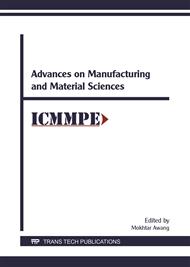[1]
Krishna1, S.J., D.G.T. Reddy, and Dr.K. Sudhakar, Effect of Electrical Current on Surface Roughness of Borosilicate Glass using EDM. International Journal of Advanced Trends in Computer Science and Engineering, 2013. 2: pp.216-218.
Google Scholar
[2]
Singh, P.N., K. Raghukandan, and B.C. Pai, Optimization by Grey relational analysis of EDM parameters on machining Al–10%SiCP composites. Journal of Materials Processing Technology, 2004. 155-156: pp.1658-1661.
DOI: 10.1016/j.jmatprotec.2004.04.322
Google Scholar
[3]
Jameson, E.C., Electrical Discharge Machining. 2001: Society of Manufacturing Engineers.
Google Scholar
[4]
Jahan, M.P., Y.S. Wong, and M. Rahman, A study on the quality micro-hole machining of tungsten carbide by micro-EDM process using transistor and RC-type pulse generator. Journal of Materials Processing Technology, 2009. 209(4): pp.1706-1716.
DOI: 10.1016/j.jmatprotec.2008.04.029
Google Scholar
[5]
Alting, L., et al., Micro Engineering. CIRP Annals - Manufacturing Technology, 2003. 52(2): pp.635-657.
Google Scholar
[6]
Kung, K. -Y., J. -T. Horng, and K. -T. Chiang, Material removal rate and electrode wear ratio study on the powder mixed electrical discharge machining of cobalt-bonded tungsten carbide. The International Journal of Advanced Manufacturing Technology, 2009. 40(1): pp.95-104.
DOI: 10.1007/s00170-007-1307-2
Google Scholar
[7]
Garg, R.K., et al., Review of research work in sinking EDM and WEDM on metal matrix composite materials. The International Journal of Advanced Manufacturing Technology, 2010. 50(5): pp.611-624.
DOI: 10.1007/s00170-010-2534-5
Google Scholar
[8]
Hourmand, M., et al., Investigating the electrical discharge machining (EDM) parameter effects on Al-Mg2Si metal matrix composite (MMC) for high material removal rate (MRR) and less EWR–RSM approach. The International Journal of Advanced Manufacturing Technology, 2014. 77(5-8): pp.831-838.
DOI: 10.1007/s00170-014-6491-2
Google Scholar
[9]
Agarwal, S.C. and H. Ocken, The microstructure and galling wear of a laser-melted cobalt-base hardfacing alloy. Wear, 1990. 140(2): pp.223-233.
DOI: 10.1016/0043-1648(90)90085-o
Google Scholar
[10]
Gatto, A., et al., Electrodischarge drilling performance on parts produced by DMLS. The International Journal of Advanced Manufacturing Technology, 2012. 58(9): pp.1003-1018.
DOI: 10.1007/s00170-011-3446-8
Google Scholar
[11]
Jeswani, M.L., Effect of the addition of graphite powder to kerosene used as the dielectric fluid in electrical discharge machining. Wear, 1981. 70(2): pp.133-139.
DOI: 10.1016/0043-1648(81)90148-4
Google Scholar
[12]
Jahan, M.P., M. Rahman, and Y.S. Wong, Study on the nano-powder-mixed sinking and milling micro-EDM of WC-Co. The International Journal of Advanced Manufacturing Technology, 2011. 53(1): pp.167-180.
DOI: 10.1007/s00170-010-2826-9
Google Scholar
[13]
Chow, H. -M., et al., Study of added powder in kerosene for the micro-slit machining of titanium alloy using electro-discharge machining. Journal of Materials Processing Technology, 2000. 101(1–3): pp.95-103.
DOI: 10.1016/s0924-0136(99)00458-6
Google Scholar
[14]
Kumar, A., et al., Analysis of Machining Characteristics in Additive Mixed Electric Discharge Machining of Nickel-Based Super Alloy Inconel 718. Materials and Manufacturing Processes, 2011. 26(8): pp.1011-1018.
DOI: 10.1080/10426914.2010.527415
Google Scholar
[15]
Bhattacharya, A., et al., Optimal parameter settings for rough and finish machining of die steels in powder-mixed EDM. The International Journal of Advanced Manufacturing Technology, 2012. 61(5): pp.537-548.
DOI: 10.1007/s00170-011-3716-5
Google Scholar
[16]
State-Ease, I., Design Expert Software Version 6 User's Guide. 2000, Minneapolis (USA): Technical Manual.
Google Scholar
[17]
Hourmand, M., et al., Investigating the electrical discharge machining (EDM) parameter effects on Al-Mg2Si metal matrix composite (MMC) for high material removal rate (MRR) and less EWR–RSM approach. The International Journal of Advanced Manufacturing Technology, 2015. 77(5): pp.831-838.
DOI: 10.1007/s00170-014-6491-2
Google Scholar
[18]
Kumar, R., I. Singh, and D. Kumar, Electro Discharge Drilling of Hybrid MMC. Procedia Engineering, 2013. 64: pp.1337-1343.
DOI: 10.1016/j.proeng.2013.09.215
Google Scholar
[19]
Yih-fong, T. and C. Fu-chen, Investigation into some surface characteristics of electrical discharge machined SKD-11 using powder-suspension dielectric oil. Journal of Materials Processing Technology, 2005. 170(1-2): pp.385-391.
DOI: 10.1016/j.jmatprotec.2005.06.006
Google Scholar


